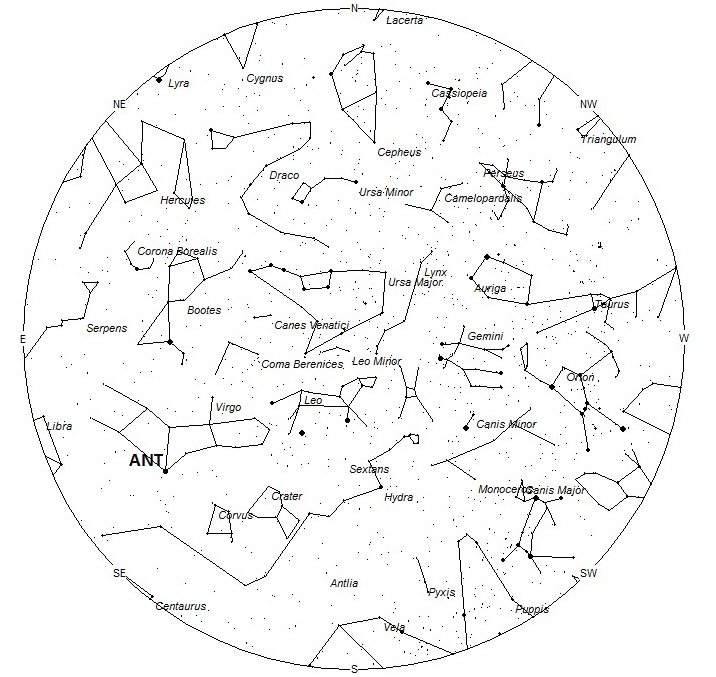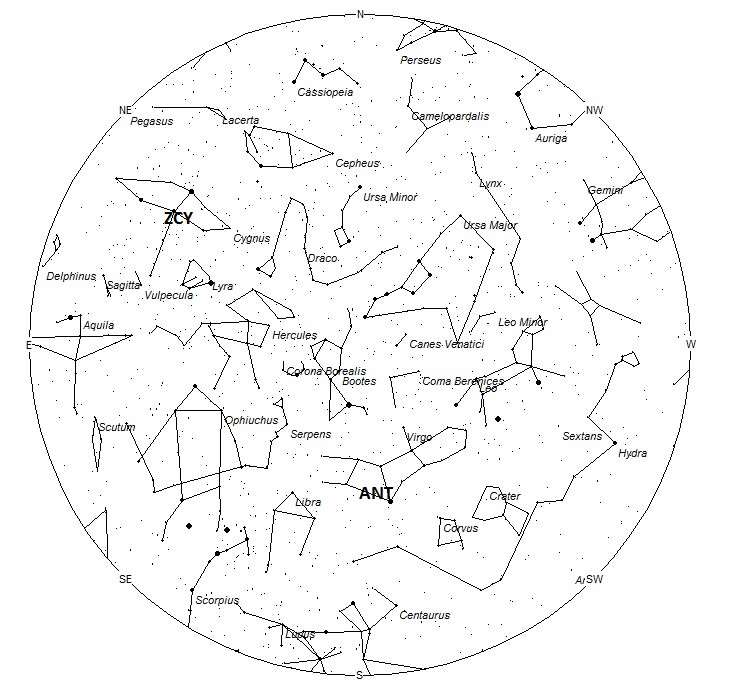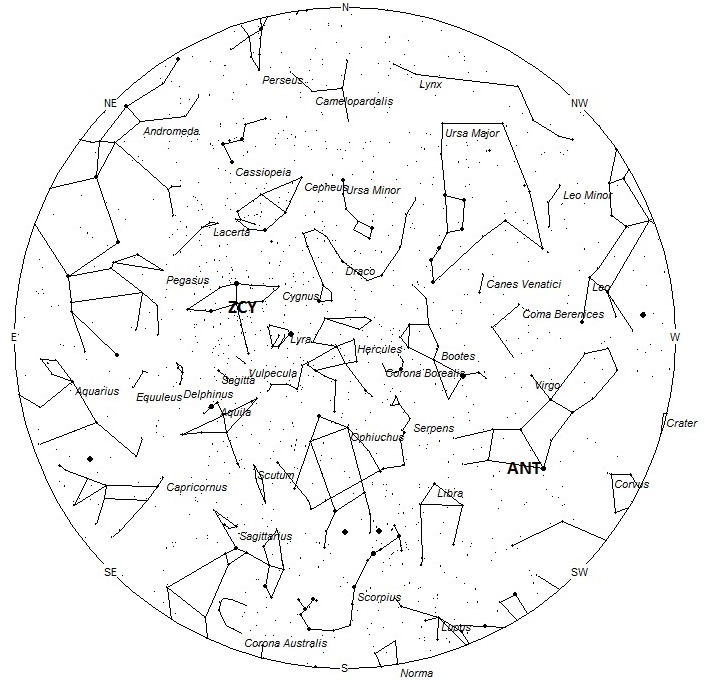Radiant Positions at 9pm Local Summer Time
Radiant Positions at 5am Local Summer Time
As I post my initial contribution to Meteor News, a little explanation is in order. I have been writing these weekly meteor activity outlooks in various forms since November 1999. The list of radiants has changed radically since 1999 due to the ever-expanding list of sources of meteor activity being constantly added. Currently there are nearly 800 radiants listed in the IAU table of meteor showers. Reducing this list down to only the working showers still leaves 563 radiants. Still at this reduced number it would be impossible of me to list all of these active showers each week and also impossible for visual observers to sort them out in the field. The list of 112 established showers is much more reasonable to work with both out in the field and on the computer. The best list I have come across was presented by Sirko Molau at the 2013 International Meteor Conference. While it too also lists some weak radiants, it provides sources that are also most likely to be detected by visual observers. It reflects a great majority of the IAU established list with a few additions and deletions (daylight showers for instance). No list is permanent as more discoveries are being made every year. I base my sources on Molau’s list plus additional radiants from all sources (SonotaCo, EDMOND, CAMS, etc.) that have been discovered since 2013 and have a real chance of being detected by visual observers.
Now for this week’s outlook…
Meteor activity picks up a bit during April as the Lyrids become active during the month. They are active from the 18th through the 25th, with a pronounced maximum on the 22nd. Sporadic rates during April are steady as seen from both hemispheres with southern observers enjoying twice the activity that can be seen from the mid-northern hemisphere.
During this period the moon reaches its new phase on Thursday April 7th. On that date the moon will be located near the sun and will not be visible at night. This weekend the waning crescent moon will rise during the early morning hours and will not pose any problems for viewing meteor activity as long as you keep the lunar glare out of your field of view. The estimated total hourly meteor rates for evening observers this week is near 3 for observers located in the northern hemisphere and 4 for observers located south of the equator. For morning observers the estimated total hourly rates should be near 9 as seen from mid-northern latitudes (45N) and 11 as seen from tropical southern locations (25S). The actual rates will also depend on factors such as personal light and motion perception, local weather conditions, alertness and experience in watching meteor activity. Note that the hourly rates listed below are estimates as viewed from dark sky sites away from urban light sources. Observers viewing from urban areas will see less activity as only the brightest meteors will be visible from such locations.
The radiant (the area of the sky where meteors appear to shoot from) positions and rates listed below are exact for Saturday night/Sunday morning April 2/3. These positions do not change greatly day to day so the listed coordinates may be used during this entire period. Most star atlases (available at science stores and planetariums) will provide maps with grid lines of the celestial coordinates so that you may find out exactly where these positions are located in the sky. A planisphere or computer planetarium program is also useful in showing the sky at any time of night on any date of the year. Activity from each radiant is best seen when it is positioned highest in the sky, either due north or south along the meridian, depending on your latitude. It must be remembered that meteor activity is rarely seen at the radiant position. Rather they shoot outwards from the radiant so it is best to center your field of view so that the radiant lies at the edge and not the center. Viewing there will allow you to easily trace the path of each meteor back to the radiant (if it is a shower member) or in another direction if it is a sporadic. Meteor activity is not seen from radiants that are located far below the horizon. The positions below are listed in a west to east manner in order of right ascension (celestial longitude). The positions listed first are located further west therefore are accessible earlier in the night while those listed further down the list rise later in the night.
These sources of meteoric activity are expected to be active this week.
The center of the large Anthelion (ANT) radiant is currently located at 13:44 (206) -10. This position lies in southern Virgo, 3 degrees northeast of the 1st magnitude star known as Spica (alpha Virginis). Due to the large size of this radiant, Anthelion activity may also appear from the nearby constellations of Corvus, eastern Hydra, and Libra as well as Virgo. This radiant is best placed near 0200 local summer time, when it lies on the meridian and is located highest in the sky. Rates at this time should be near 3 per hour no matter your location. With an entry velocity of 30 km/sec., the average Anthelion meteor would be of slow velocity.
The Zeta Cygnids (ZCY) were first detected by Zdenek Sekanina and mentioned in his article on a study of radio streams. These meteors are active from April 3-10 with maximum activity occurring on the 5th. At maximum the radiant is located at 20:08 (302) +40. This area of the sky is located in central Cygnus just 2 degrees west of the 2nd magnitude star known as Sadr (gamma Cygni). Note that this position is nowhere close to the star zeta Cygni which lies on the east side of the constellation. This usually occurs when activity is suspected from a radiant and further studies indicate the radiant actually lies in another position. Rather than correcting the name the original name is kept so that the association of earlier observations and that of newer data remains intact. This may confuse new observers but luckily this does not occur often among the lists of radiants. This radiant is best placed during the last hour before dawn when it lies highest above the horizon in a dark sky. Rates at maximum should be near 1 per hour just before dawn as seen from mid-northern latitudes. Unfortunately these meteors are not well seen from south of the equator. With an entry velocity of 40 km/sec., the average meteor from this source would be of medium velocity.
As seen from the mid-northern hemisphere (45N) one would expect to see approximately 5 sporadic meteors per hour during the last hour before dawn as seen from rural observing sites. Evening rates would be near 2 per hour. As seen from the tropical southern latitudes (25S), morning rates would be near 8 per hour as seen from rural observing sites and 3 per hour during the evening hours. Locations between these two extremes would see activity between the listed figures.
The list below offers the information from above in tabular form. Rates and positions are exact for Saturday night/Sunday morning except where noted in the shower descriptions.
| SHOWER | DATE OF MAXIMUM ACTIVITY | CELESTIAL POSITION | ENTRY VELOCITY | CULMINATION | HOURLY RATE | CLASS |
| RA (RA in Deg.) DEC | Km/Sec | Local Summer Time | North-South | |||
| Anthelions (ANT) | – | 13:44 (206) -10 | 30 | 02:00 | 3 – 3 | II |
| zeta Cygnids (ZCY) | Apr 05 | 20:08 (302) +40 | 40 | 08:00 | 1 – <1 | IV |




